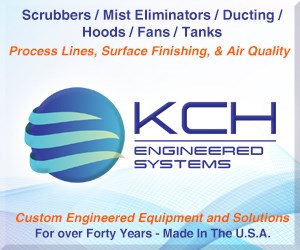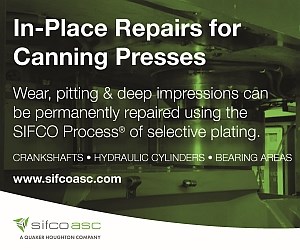Electroplating
NOx Scrubbing Solution Boosts Safety, Efficiency
Unlike typical nitrogen oxide sulfide/caustic control chemistry, Bionomic Industries’ low-toxicity BioNOxSolver scrubbing solution is formulated so that it will not liberate flammable and dangerous hydrogen sulfide gas at pH-use conditions.
Read MoreValence Wichita Receives Approvals from Boeing, Bombardier
The Kansas facility now holds hardness and conductivity approvals from Airbus, Cessna, Spirit, Boeing and Bombardier.
Read MoreMichigan Takes Steps to Eliminate PFOS, PFOA and PFAS
The Michigan Department of Environmental Quality (DEQ) is requiring wastewater treatment plants with industrial pretreatment programs to screen for and eliminate these compounds commonly used in the metal-finishing industry.
Read MoreNASF Seeks Nomination for Industry Awards
The NASF will recognize a number of well-deserving individuals in several different awards categories. Nominations are due by March 30.
Read MoreMore Efficient Zinc-Nickel Plating
The addition of a porous membrane in Coventya’s system results in less breakdown product and more cathode efficiency.
Read MoreFormation of Trivalent Chromium Passivation Layers
The trivalent process is proven to be a safe replacement for hex chrome, but fundamental knowledge of its composition is required.
Read MoreChoosing the Best Electrolytic Nickel Strike
Now that you have decided that an electrolytic nickel strike would benefit your process, how do you choose the best one for your application? Coventya’s Brad Durkin explains.
Read MoreAsterion to Host Certified Electroplater-Finisher Training
The course, to be presented by the AESF Foundation, will be held April 30-May 4, at the Drury Plaza Hotel in Indianapolis, Indiana.
Read MoreElectroless Nickel Coatings: Appearance, Gloss and Surface Morphology
For decorative coatings, appearance is the essential purpose for application, but also for functional surface finishes it becomes increasingly relevant as an added value on top of specified technical requirements. Appearance is affected by spectrum and intensity of incident light, roughness and morphology of the coating surface, optical properties of the coating material, eventual superficial oxide films, and individual perception. The predominant factor is surface roughness, which in turn depends on base material roughness, quality of substrate pretreatment, and nucleation and growth kinetics of the electroless nickel (EN) deposit. Interdependency of gloss measurements with roughness measurements and with chemical composition of coatings was investigated for new generation mid-P EN processes and compared to traditional ones.
Read MoreNanostructures by Anodization of Alumina in Phosphoric Acid at Low Potential
Anodic aluminum oxide (AAO) has been investigated, in terms of influence of the process time, anodizing potential and methanol addition on the structural features of porous anodic alumina formed in 0.1M H3PO4 solution by two-step self-organized anodizing for potentials ranging from 100-150 V. The structural features of the porous structures, including pore diameter and interpore distance, were evaluated from FE-SEM top-view images for samples anodized in the presence and absence of methanol.
Read More













.jpg;maxWidth=300;quality=90)


